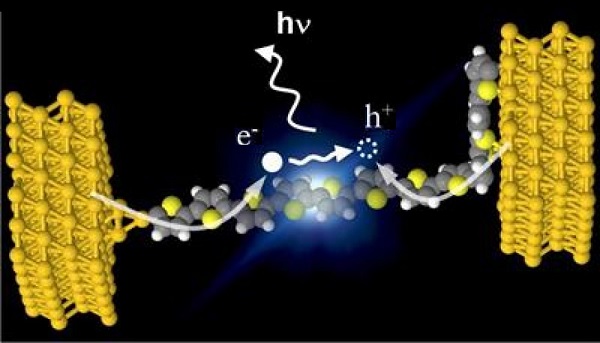 An electron in a molecule-wide fiber sets off a photon in the world's smallest LED.[/caption] French researchers have developed a light-emitting diode (LED) so small that the business end consists of only a single molecule at the end of a nanowire. The device features a polythiophene nanowire running from the tip of an electron-scanning-tunneling microscope to a gold surface. When current runs up the wire toward the gold surface, the end of the wire lights up. When current runs in the other direction, almost no light is produced, according to the paper published in Physical Review Letters by a team at France's Institut de Physique et de Chimie des Matériaux de Strasbourg. The LED behaves just like any organic LED (OLED), according to a statement released by the research team. OLEDs are the current cutting-edge material in smartphones, televisions, and other devices, including the flexible screen on Samsung's Galaxy Round and a range of flexible OLED lighting panels. The difference in this case is that the light came from a single molecule at the end of a strand of wire only one molecule wide. Polythiophene, which consists of hydrogen, carbon and sulfur, isn't common, but is used to make ultra-small LEDs already in use in commercial and experimental applications. There are currently very few applications for a light source only one molecule across, but that may change as microprocessor developers continue to design components using both optical and electrical connections, such as Intel's Silicon Photonics, which rely on silicon as the medium and light, rather than electricity, to carry data. This device is only a proof of concept, but could be the first step toward the development of molecule-sized components for Systems-on-a-Chip or entire computers only a few molecules wide. Image: Guillaume Schull - IPCMS
An electron in a molecule-wide fiber sets off a photon in the world's smallest LED.[/caption] French researchers have developed a light-emitting diode (LED) so small that the business end consists of only a single molecule at the end of a nanowire. The device features a polythiophene nanowire running from the tip of an electron-scanning-tunneling microscope to a gold surface. When current runs up the wire toward the gold surface, the end of the wire lights up. When current runs in the other direction, almost no light is produced, according to the paper published in Physical Review Letters by a team at France's Institut de Physique et de Chimie des Matériaux de Strasbourg. The LED behaves just like any organic LED (OLED), according to a statement released by the research team. OLEDs are the current cutting-edge material in smartphones, televisions, and other devices, including the flexible screen on Samsung's Galaxy Round and a range of flexible OLED lighting panels. The difference in this case is that the light came from a single molecule at the end of a strand of wire only one molecule wide. Polythiophene, which consists of hydrogen, carbon and sulfur, isn't common, but is used to make ultra-small LEDs already in use in commercial and experimental applications. There are currently very few applications for a light source only one molecule across, but that may change as microprocessor developers continue to design components using both optical and electrical connections, such as Intel's Silicon Photonics, which rely on silicon as the medium and light, rather than electricity, to carry data. This device is only a proof of concept, but could be the first step toward the development of molecule-sized components for Systems-on-a-Chip or entire computers only a few molecules wide. Image: Guillaume Schull - IPCMS One-Molecule LED Hints at Nanoscale Computers
[caption id="attachment_16889" align="aligncenter" width="600"] An electron in a molecule-wide fiber sets off a photon in the world's smallest LED.[/caption] French researchers have developed a light-emitting diode (LED) so small that the business end consists of only a single molecule at the end of a nanowire. The device features a polythiophene nanowire running from the tip of an electron-scanning-tunneling microscope to a gold surface. When current runs up the wire toward the gold surface, the end of the wire lights up. When current runs in the other direction, almost no light is produced, according to the paper published in Physical Review Letters by a team at France's Institut de Physique et de Chimie des Matériaux de Strasbourg. The LED behaves just like any organic LED (OLED), according to a statement released by the research team. OLEDs are the current cutting-edge material in smartphones, televisions, and other devices, including the flexible screen on Samsung's Galaxy Round and a range of flexible OLED lighting panels. The difference in this case is that the light came from a single molecule at the end of a strand of wire only one molecule wide. Polythiophene, which consists of hydrogen, carbon and sulfur, isn't common, but is used to make ultra-small LEDs already in use in commercial and experimental applications. There are currently very few applications for a light source only one molecule across, but that may change as microprocessor developers continue to design components using both optical and electrical connections, such as Intel's Silicon Photonics, which rely on silicon as the medium and light, rather than electricity, to carry data. This device is only a proof of concept, but could be the first step toward the development of molecule-sized components for Systems-on-a-Chip or entire computers only a few molecules wide. Image: Guillaume Schull - IPCMS
An electron in a molecule-wide fiber sets off a photon in the world's smallest LED.[/caption] French researchers have developed a light-emitting diode (LED) so small that the business end consists of only a single molecule at the end of a nanowire. The device features a polythiophene nanowire running from the tip of an electron-scanning-tunneling microscope to a gold surface. When current runs up the wire toward the gold surface, the end of the wire lights up. When current runs in the other direction, almost no light is produced, according to the paper published in Physical Review Letters by a team at France's Institut de Physique et de Chimie des Matériaux de Strasbourg. The LED behaves just like any organic LED (OLED), according to a statement released by the research team. OLEDs are the current cutting-edge material in smartphones, televisions, and other devices, including the flexible screen on Samsung's Galaxy Round and a range of flexible OLED lighting panels. The difference in this case is that the light came from a single molecule at the end of a strand of wire only one molecule wide. Polythiophene, which consists of hydrogen, carbon and sulfur, isn't common, but is used to make ultra-small LEDs already in use in commercial and experimental applications. There are currently very few applications for a light source only one molecule across, but that may change as microprocessor developers continue to design components using both optical and electrical connections, such as Intel's Silicon Photonics, which rely on silicon as the medium and light, rather than electricity, to carry data. This device is only a proof of concept, but could be the first step toward the development of molecule-sized components for Systems-on-a-Chip or entire computers only a few molecules wide. Image: Guillaume Schull - IPCMS
 An electron in a molecule-wide fiber sets off a photon in the world's smallest LED.[/caption] French researchers have developed a light-emitting diode (LED) so small that the business end consists of only a single molecule at the end of a nanowire. The device features a polythiophene nanowire running from the tip of an electron-scanning-tunneling microscope to a gold surface. When current runs up the wire toward the gold surface, the end of the wire lights up. When current runs in the other direction, almost no light is produced, according to the paper published in Physical Review Letters by a team at France's Institut de Physique et de Chimie des Matériaux de Strasbourg. The LED behaves just like any organic LED (OLED), according to a statement released by the research team. OLEDs are the current cutting-edge material in smartphones, televisions, and other devices, including the flexible screen on Samsung's Galaxy Round and a range of flexible OLED lighting panels. The difference in this case is that the light came from a single molecule at the end of a strand of wire only one molecule wide. Polythiophene, which consists of hydrogen, carbon and sulfur, isn't common, but is used to make ultra-small LEDs already in use in commercial and experimental applications. There are currently very few applications for a light source only one molecule across, but that may change as microprocessor developers continue to design components using both optical and electrical connections, such as Intel's Silicon Photonics, which rely on silicon as the medium and light, rather than electricity, to carry data. This device is only a proof of concept, but could be the first step toward the development of molecule-sized components for Systems-on-a-Chip or entire computers only a few molecules wide. Image: Guillaume Schull - IPCMS
An electron in a molecule-wide fiber sets off a photon in the world's smallest LED.[/caption] French researchers have developed a light-emitting diode (LED) so small that the business end consists of only a single molecule at the end of a nanowire. The device features a polythiophene nanowire running from the tip of an electron-scanning-tunneling microscope to a gold surface. When current runs up the wire toward the gold surface, the end of the wire lights up. When current runs in the other direction, almost no light is produced, according to the paper published in Physical Review Letters by a team at France's Institut de Physique et de Chimie des Matériaux de Strasbourg. The LED behaves just like any organic LED (OLED), according to a statement released by the research team. OLEDs are the current cutting-edge material in smartphones, televisions, and other devices, including the flexible screen on Samsung's Galaxy Round and a range of flexible OLED lighting panels. The difference in this case is that the light came from a single molecule at the end of a strand of wire only one molecule wide. Polythiophene, which consists of hydrogen, carbon and sulfur, isn't common, but is used to make ultra-small LEDs already in use in commercial and experimental applications. There are currently very few applications for a light source only one molecule across, but that may change as microprocessor developers continue to design components using both optical and electrical connections, such as Intel's Silicon Photonics, which rely on silicon as the medium and light, rather than electricity, to carry data. This device is only a proof of concept, but could be the first step toward the development of molecule-sized components for Systems-on-a-Chip or entire computers only a few molecules wide. Image: Guillaume Schull - IPCMS 
![Go to article Pinterest's Move Hints at Growth [DiceTV]](/binaries/small/content/gallery/dice/insights/2012/08/dice-tv-8-2-12-thumbnail.jpg)